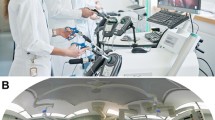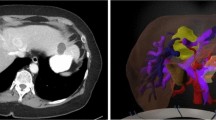Abstract
Purpose
Virtual reality (VR) applications with head-mounted displays (HMDs) have had an impact on information and multimedia technologies. The current work aimed to describe the process of developing a highly immersive VR simulation for laparoscopic surgery.
Methods
We combined a VR laparoscopy simulator (LapSim) and a VR-HMD to create a user-friendly VR simulation scenario. Continuous clinical feedback was an essential aspect of the development process. We created an artificial VR (AVR) scenario by integrating the simulator video output with VR game components of figures and equipment in an operating room. We also created a highly immersive VR surrounding (IVR) by integrating the simulator video output with a \(360{^{\circ }}\) video of a standard laparoscopy scenario in the department’s operating room.
Results
Clinical feedback led to optimization of the visualization, synchronization, and resolution of the virtual operating rooms (in both the IVR and the AVR). Preliminary testing results revealed that individuals experienced a high degree of exhilaration and presence, with rare events of motion sickness. The technical performance showed no significant difference compared to that achieved with the standard LapSim.
Conclusion
Our results provided a proof of concept for the technical feasibility of an custom highly immersive VR-HMD setup. Future technical research is needed to improve the visualization, immersion, and capability of interacting within the virtual scenario.




Similar content being viewed by others
References
Aggarwal R, Grantcharov TP, Eriksen JR, Blirup D, Kristiansen VB, Funch-Jensen P, Darzi A (2006) An evidence-based virtual reality training program for novice laparoscopic surgeons. Ann Surg 244(2):310–314. https://doi.org/10.1097/01.sla.0000218094.92650.44
van Dongen KW, van der Wal WA, Rinkes IH, Schijven MP, Broeders IA (2008) Virtual reality training for endoscopic surgery: voluntary or obligatory? Surg Endosc 22(3):664–667. https://doi.org/10.1007/s00464-007-9456-9
Huber T, Kirschniak A, Johannink J (2017) Survey of training in laparoscopic skills in Germany. Zentralbl Chir 142(1):67–71. https://doi.org/10.1055/s-0042-116327
Earle D, Betti D, Scala E (2017) Development of a rapid response plan for intraoperative emergencies: the Circulate, Scrub, and Technical Assistance Team. Am J Surg 213(1):181–186. https://doi.org/10.1016/j.amjsurg.2016.01.047
Chirico A, Yaden DB, Riva G, Gaggioli A (2016) The potential of virtual reality for the investigation of awe. Front Psychol 7:1766. https://doi.org/10.3389/fpsyg.2016.01766
Schmitt YS, Hoffman HG, Blough DK, Patterson DR, Jensen MP, Soltani M, Carrougher GJ, Nakamura D, Sharar SR (2011) A randomized, controlled trial of immersive virtual reality analgesia, during physical therapy for pediatric burns. Burns 37(1):61–68. https://doi.org/10.1016/j.burns.2010.07.007
Rizzo A, Hartholt A, Grimani M, Leeds A, Liewer M (2014) Virtual reality exposure therapy for combat-related posttraumatic stress disorder. Computer 47(7):31–37
Laver KE, George S, Thomas S, Deutsch JE, Crotty M (2015) Virtual reality for stroke rehabilitation. Cochrane Database Syst Rev. https://doi.org/10.1002/14651858.CD008349.pub3
Parsons TD (2015) Virtual reality for enhanced ecological validity and experimental control in the clinical, affective and social neurosciences. Front Hum Neurosci 9:660. https://doi.org/10.3389/fnhum.2015.00660
Riva G (2003) Applications of virtual environments in medicine. Methods Inf Med 42(5):524–534
Olasky J, Sankaranarayanan G, Seymour NE, Magee JH, Enquobahrie A, Lin MC, Aggarwal R, Brunt LM, Schwaitzberg SD, Cao CG, De S, Jones DB (2015) Identifying opportunities for virtual reality simulation in surgical education: a review of the proceedings from the innovation, design, and emerging alliances in surgery (IDEAS) conference: VR surgery. Surg Innov 22(5):514–521. https://doi.org/10.1177/1553350615583559
Paschold M, Schroder M, Kauff DW, Gorbauch T, Herzer M, Lang H, Kneist W (2011) Virtual reality laparoscopy: which potential trainee starts with a higher proficiency level? Int J Comput Assist Radiol Surg 6(5):653–662. https://doi.org/10.1007/s11548-010-0542-4
Larsen CR, Soerensen JL, Grantcharov TP, Dalsgaard T, Schouenborg L, Ottosen C, Schroeder TV, Ottesen BS (2009) Effect of virtual reality training on laparoscopic surgery: randomised controlled trial. BMJ 338:b1802. https://doi.org/10.1136/bmj.b1802
Nagendran M, Gurusamy KS, Aggarwal R, Loizidou M, Davidson BR (2013) Virtual reality training for surgical trainees in laparoscopic surgery. Cochrane Database Syst Rev. https://doi.org/10.1002/14651858.CD006575.pub3
Paschold M, Huber T, Kauff DW, Buchheim K, Lang H, Kneist W (2014) Preconditioning in laparoscopic surgery-results of a virtual reality pilot study. Langenbecks Arch Surg 399(7):889–895. https://doi.org/10.1007/s00423-014-1224-4
Kneist W, Huber T, Paschold M, Lang H (2016) 3D virtual reality laparoscopic simulation in surgical education—results of a pilot study. Zentralbl Chir 141(3):297–301. https://doi.org/10.1055/s-0033-1350609
Sorensen SM, Savran MM, Konge L, Bjerrum F (2016) Three-dimensional versus two-dimensional vision in laparoscopy: a systematic review. Surg Endosc 30(1):11–23. https://doi.org/10.1007/s00464-015-4189-7
Tillou X, Collon S, Martin-Francois S, Doerfler A (2016) Robotic surgery simulator: elements to build a training program. J Surg Educ 73(5):870–878. https://doi.org/10.1016/j.jsurg.2016.04.008
Sankaranarayanan G, Li B, Manser K, Jones SB, Jones DB, Schwaitzberg S, Cao CG, De S (2016) Face and construct validation of a next generation virtual reality (Gen2-VR) surgical simulator. Surg Endosc 30(3):979–985. https://doi.org/10.1007/s00464-015-4278-7
LaValle SM, Yershova A, Katsev M, Antonov M (2014) Head tracking for the Oculus Rift. In: IEEE international conference on robotics and automation (ICRA). IEEE, pp 187–194
Evangelakos D, Mara M (2016) Extended TimeWarp latency compensation for virtual reality. In: Proceedings of the 20th ACM SIGGRAPH symposium on interactive 3D graphics and games, ACM, pp 193–194
Coburn JQ, Freeman I, Salmon JL (2017) A review of the capabilities of current low-cost virtual reality technology and its potential to enhance the design process. J Comput Inf Sci Eng 17(3):031013
Nichols S, Haldane C, Wilson JR (2000) Measurement of presence and its consequences in virtual environments. Int J Hum Comput Stud 52(3):471–491. https://doi.org/10.1006/ijhc.1999.0343
Madary M, Metzinger TK (2016) Real virtuality: a code of ethical conduct. Recommendations for good scientific practice and the consumers of VR-technology. Front Robot AI. https://doi.org/10.3389/frobt.2016.00003
Keshavarz B, Hecht H (2011) Validating an efficient method to quantify motion sickness. Hum Factors J Hum Factors Ergon Soc 53(4):415–426. https://doi.org/10.1177/0018720811403736
Huber T, Paschold M, Hansen C, Wunderling T, Lang H, Kneist W (2017) New dimensions in surgical training: immersive virtual reality laparoscopic simulation exhilarates surgical staff. Surg Endosc. https://doi.org/10.1007/s00464-017-5500-6
Huber T, Paschold M, Hansen C, Lang H, Kneist W (2017) I will do laparoscopy somewhere else: total, highly immersive virtual reality without side effects? Chirurg. https://doi.org/10.1007/s00104-017-0465-5
Bowman DA, McMahan RP (2007) Virtual reality: how much immersion is enough? Computer 40(7):36–43. https://doi.org/10.1109/MC.2007.257
Milgram P, Takemura H, Utsumi A, Kishino F (1995) Augmented reality: a class of displays on the reality-virtuality continuum. SPIE Proceedings 2351(1):282–292. https://doi.org/10.1117/12.197321
Cho J-M, Kim Y-D, Jung SH, Shin H, Kim T (2017) 78-4: Screen door effect mitigation and its quantitative evaluation in VR display. SID Symposium Digest of Technical Papers 48(1):1154–1156. https://doi.org/10.1002/sdtp.11846
Acknowledgements
The authors thank S. Rohde, B. Golla, and M. Kosta (University of Magdeburg) for technical support. Additionally, we appreciate the support from and discussions with H. Hecht, Department of General Experimental Psychology, Johannes Gutenberg University, Mainz.
Funding Financial support for the laparoscopy simulator was provided by the medical education project, “MAICUM,” from the Medical Center of the Johannes Gutenberg University of Mainz. Funding for the additional immersive virtual reality hardware was provided by intramural funding from the Medical Center of the Johannes Gutenberg University of Mainz, Germany, and educational intramural funding by the Otto-von-Guericke University Magdeburg, Germany.
Author information
Authors and Affiliations
Corresponding author
Ethics declarations
Conflict of interest
The authors TH, TW, MP, HL, WK and CH declare no conflicts of interest or financial ties related to this study.
Ethical approval
For this type of study, formal consent was not required. This study did not include patients or animals.
Informed consent
This article does not contain patient data.
Electronic supplementary material
Below is the link to the electronic supplementary material.
Supplementary material 1 (mp4 57811 KB)
Rights and permissions
About this article
Cite this article
Huber, T., Wunderling, T., Paschold, M. et al. Highly immersive virtual reality laparoscopy simulation: development and future aspects. Int J CARS 13, 281–290 (2018). https://doi.org/10.1007/s11548-017-1686-2
Received:
Accepted:
Published:
Issue Date:
DOI: https://doi.org/10.1007/s11548-017-1686-2




